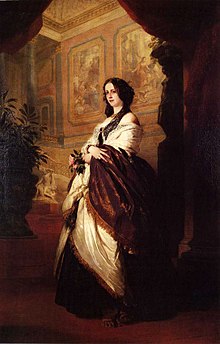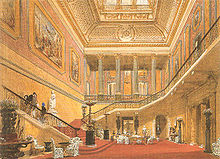|
Harriet Sutherland-Leveson-Gower, Duchess of Sutherland
Harriet Elizabeth Georgiana Sutherland-Leveson-Gower,[note 1] Duchess of Sutherland (née Howard; 21 May 1806 – 27 October 1868), styled The Honourable Harriet Howard before her marriage, was an English courtier and abolitionist from the Howard family. She was Mistress of the Robes under several Whig administrations: 1837–1841, 1846–1852, 1853–1858, and 1859–1861; and a great friend of Queen Victoria. She was an important figure in London's high society, and used her social position to undertake various philanthropic undertakings including the protest of the English ladies against American slavery. Family and early lifeHarriet was the third daughter of George Howard, 6th Earl of Carlisle and his wife Lady Georgiana Cavendish, who was a daughter of Georgiana, Duchess of Devonshire.[2] MarriageOn 18 May 1823, she married her cousin George Sutherland-Leveson-Gower, Earl Gower (1786–1861),[2] who had been elected MP for St Mawes, Cornwall (a rotten borough) in 1808, and succeeded his father as second Duke of Sutherland in 1833. Gower was twenty years older than she, but their union proved one of affection and produced four sons and seven daughters.[2][3] The Duchess of Sutherland held a social position of high influence, aided by her friendship to Queen Victoria as well as her family's great wealth.[4] By the Duchess's influence Stafford House, St. James's Palace, became an important centre of society,[5] and the starting-point of various philanthropic undertakings. The Duchess helped organise the "Stafford House Address" petition against slavery, and former American First Lady Julia Tyler wrote a defence of slavery titled "The Women of England vs. the Women of America", in response to it.[6][7] In response to "The Women of England vs. the Women of America", former slave Harriet Jacobs wrote a letter to the New York Tribune which was her first published writing; it was published in 1853 and signed "Fugitive".[8][9] The Duchess's stance on slavery was heavily criticised by Karl Marx because her mother-in-law, the previous Duchess, had been closely associated with the clearance of the inhabitants of Sutherland thirty years earlier, so that she could reuse 794,000 acres (3200 km2) of land for commercial sheep farming.[10] Mistress of the Robes On the accession of Queen Victoria the Duchess was appointed Mistress of the Robes,[note 2] and held that post whenever the Whigs were in office until her husband's death (August 1837 to September 1841, July 1846 to March 1852, January 1853 to February 1858, June 1859 to April 1861). In that role, she presided at the coronation of Queen Victoria in 1838. [12] From the Queen's refusal to part with the Duchess and her other ladies arose the Bedchamber Crisis of 1839, which resulted in the Whigs returning to office. Victoria gave a sympathetic description of the Duchess's character,[13] and after the death of Prince Albert, the prince consort, spent the first weeks of her widowhood with the Duchess as her only companion.[14]  Queen Victoria is said to have remarked to the Duchess on arriving at Stafford House, "I have come from my House to your Palace." With its ornate decoration and the dramatic sweep of the great staircase, the Grand Hall is a magnificent introduction to one of the finest town houses in London.[15] In 1861 the 4th Rogart Company of the 1st Sutherland Volunteer Rifle Corps formed up. The company bore the title "Duchess Harriet's Company Rogart" upon the pouch-belt plate.[16] The Duchess's last public appearance was at the Prince of Wales's marriage in 1863. In that year she was seized with an illness from which she never recovered. However, she was able to entertain Garibaldi, for whom she had great admiration, at Chiswick House and Trentham, Staffordshire, during his visit to England in April 1864. She died on 27 October 1868[14] at her London residence, Stafford House, aged 62. She was interred in the mausoleum of the Dukes of Sutherland at Trentham. W E Gladstone was one of the pall-bearers at her funeral.[17] The Duchess's letters, some of which were published by her son Lord Ronald Gower in Stafford House Letters,[18] parts iv-vi., prove her to have had an affectionate disposition, with some sense of humour. She had also an interest in architecture and gardening.[14] IssueOn 18 May 1823 Harriet married George Sutherland-Leveson-Gower, Earl Gower, eldest son of the 2nd Marquess of Stafford, and a man twenty years her senior. Her father-in-law was created Duke of Sutherland in 1833, and was succeeded by his son later that year, whereupon Harriet became the Duchess of Sutherland.[citation needed] They had eleven children:
In 1871, while her son-in-law, the Duke of Argyll, was serving in the Cabinet, his son (Harriet's grandson), Lord Lorne, married one of Victoria's daughters, Princess Louise. Harriet's eldest son became 3rd Duke of Sutherland in 1861.[citation needed] In mediaHarriet was portrayed by Rachael Stirling in the 2009 film The Young Victoria. She was portrayed by Margaret Clunie in the 2016 ITV series Victoria, though she is inaccurately depicted as carrying on an improbable romance with Prince Ernest of Saxe-Coburg and Gotha (later Duke of Saxe-Coburg and Gotha), who is also inaccurately depicted as being unmarried at the time.[citation needed] Ancestry
Notes
References
Works cited
External linksWikimedia Commons has media related to Harriet, Duchess of Sutherland.
|
|||||||||||||||||||||||||||||||||||||||||||||||||||||||||||||||||||||||||||||||||||||||||||||||||||||||||||||||||||||||||||||||||||||||||||||||||||||||||||||||||||||||||||||||||||||||||||||||||||||||||||||||||||||||||||||||||||||||||||||||||||||||||||||||||||||||||||||||||||||||||||||||||||||||||||||||||||
